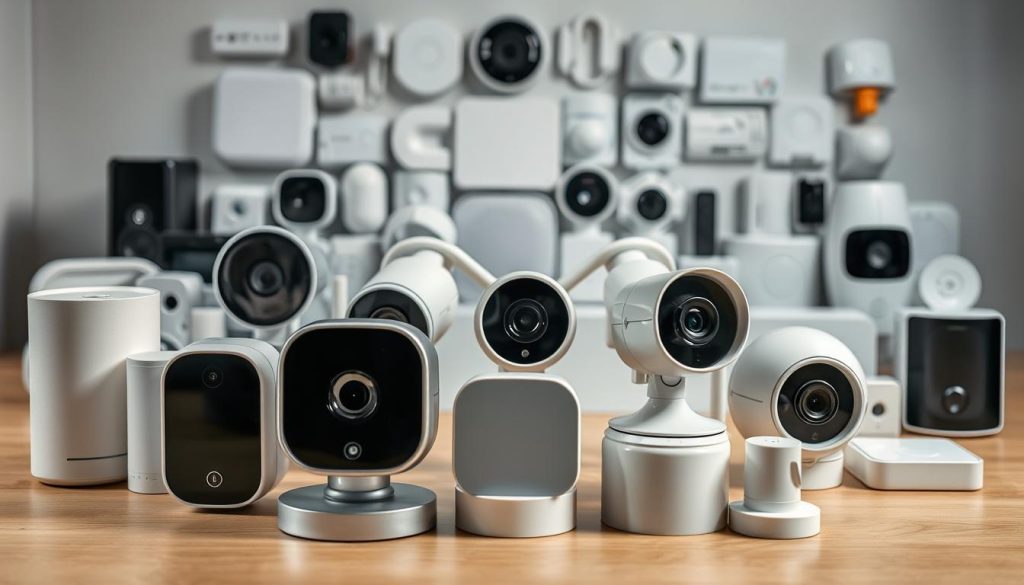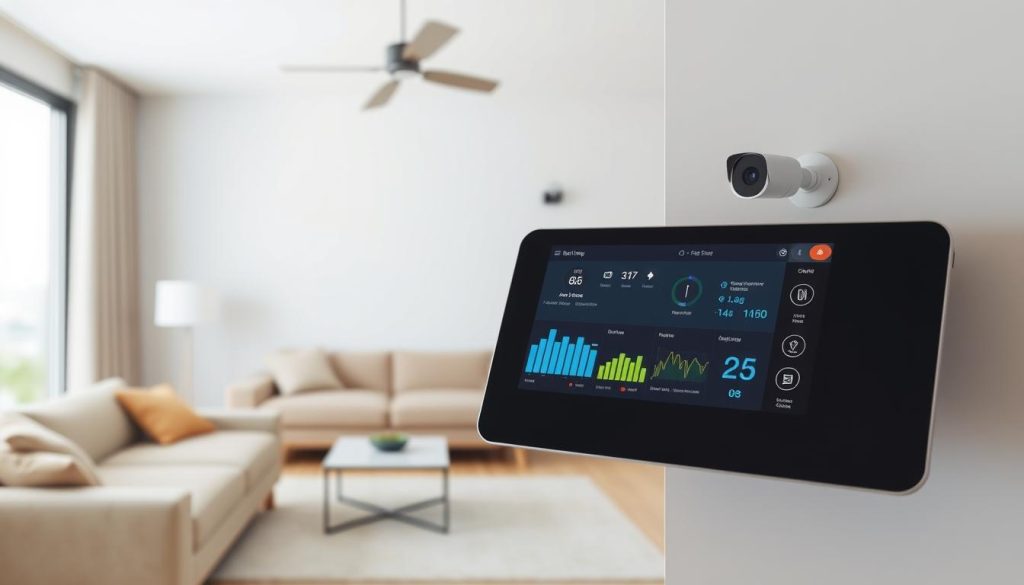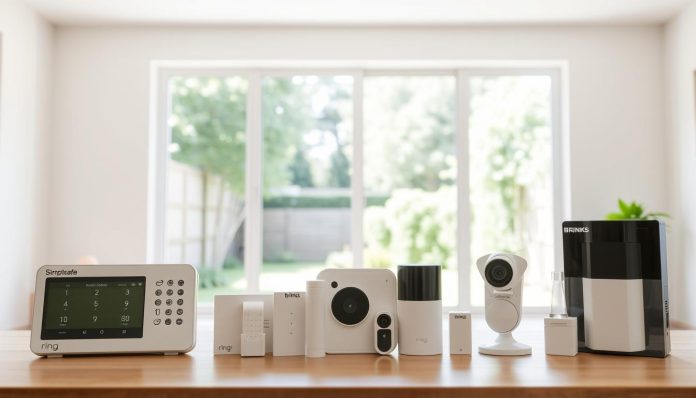You need a clear, concise comparison to pick the right solution for your place. This guide gives a side-by-side look at three top companies so you can weigh features, monitoring costs, and real-world setup time.
In hands-on testing both brands proved fast to install, with one offering peel-and-stick sensors and the other requiring device-by-device pairing for best results. You’ll also see where each option shines: broader sensor kits, camera ecosystems, or contract and warranty trade-offs.
We break down monitoring pricing, smart-home integrations like Alexa and Google, and contract terms so you know the long-term cost and service risks. By the end, you’ll understand which setup fits renters, camera-first homes, or those who want verified video response.
How to choose a DIY home security system that fits your home, budget, and comfort level
Begin with a simple map: mark doors, windows, and outdoor zones to estimate how many sensors and devices you need.
Set a monthly budget next. Compare plan details, not just price. Look for professional monitoring, cloud video, cellular backup, and video verification so you know what each plan includes.
Think about installation—if you prefer plug-and-play, choose options with peel-and-stick sensors and clear in-app setup. If you want automation or Z-Wave support, pick systems that expand with locks and smart plugs.
- Evaluate app usability by checking recent iOS and Android reviews.
- Prioritize month-to-month plans if you want flexibility; avoid long contracts if you move often.
- Plan for growth: start small and add devices without extra penalties.
| Need | What to check | Why it matters |
|---|---|---|
| Coverage | Entry points, rooms, outdoor | Right-size equipment and cost |
| Plan | Monitoring tiers, video, backup | Protects against outages and false alarms |
| Installation | DIY ease or pro install | Matches your comfort and schedule |
SimpliSafe vs Ring Alarm vs Brinks: Which DIY Home Security System Is Best?
We compare each company’s gear, install flow, and monthly plans to highlight practical strengths and trade-offs.
The equipment lineup differs by focus. One vendor leads with glass-break sensors, sirens, panic buttons, and key fobs. Another pairs a base station and keypad with a broad doorbell and camera family. The third offers the deepest sensor selection and strong Z-Wave add-ons for smart automation.
Installation speed matters. Expect the quickest setup from peel-and-stick sensors and a simple pairing flow. Some setups require syncing devices one at a time, which takes longer. The third option lets you choose either a self-install or professional install if you prefer help.

Monitoring costs and app quality shape value. Monthly plans range from low-cost video storage to tiers that add professional monitoring and video verification for faster police response. Both top apps rate well; one app is lean and simple, the other is feature-rich but busier.
- Security-focused sensors for intrusion and alarms.
- Broad camera and doorbell choices for video coverage.
- Z-Wave device depth for advanced automation.
| Area | Strength | What it means for you |
|---|---|---|
| Equipment | Sensor depth / cameras / Z-Wave | Pick the gear that matches your rooms and automation goals |
| Installation | Peel-and-stick fastest; device-by-device slower; pro option | Consider time and whether you want professional install help |
| Monitoring & apps | From basic video plans to verified professional monitoring | Balance monthly cost against features like video verification |
After weighing equipment, install ease, and monitoring, many reviewers name the overall winner for balance of value and experience. You should choose the option that fits your layout, budget, and how much automation you want for your home over the years.
Equipment and devices: sensors, cameras, and add-ons you’ll actually use
Focus on the devices that solve real problems: entry sensors for doors, motion sensors for main corridors, and cameras for visible sightlines.

Starter kits typically include a base station, keypad, and contact sensors. Many kits add motion detectors and a range extender if signal reach matters in larger layouts.
You’ll get the most robust sensor selection from two providers, with one bundling sirens, panic buttons, and glass-break sensors that raise overall security. Another vendor leads in camera models and doorbell choices, giving more options for video coverage.
- Match entry sensors and motion detectors to your floor plan.
- Add specialty sensors for high-risk areas and sirens/key fobs for quick access.
- Place indoor and outdoor security cameras at the front door, driveway, and backyard to cut blind spots.
| Device | Typical inclusion | Why it matters |
|---|---|---|
| Entry sensors | Included in most kits | Primary contact point detection for doors/windows |
| Motion sensors | Standard in starter packs | Covers interior movement and reduces false triggers |
| Cameras & video doorbell | Wide model range from one vendor; fewer models from another | Provides verification, deterrence, and two-way talk |
| Range extender / Z-Wave devices | Optional add-on | Improves signal and expands automation options |
DIY installation and professional setup: speed, simplicity, and what to expect
A fast, painless setup starts with dry-fitting sensors, placing the base centrally, and pairing devices one at a time.
Peel-and-stick sensors remove drilling and often make installation the quickest path. A plug-in base and guided app steps usually let most homes finish in under an hour.
For systems that require device-by-device pairing, plan for extra time. Syncing one device at a time and following video tutorials reduces frustration and avoids mass-sync errors.

- Consider professional installation if wiring a doorbell or if your layout is large and complex.
- Place the base station centrally and add range extenders where needed to improve reliability.
- Dry-fit contact sensors before using adhesive and use mounting hardware in high-traffic spots.
| Task | Typical time | Why it matters |
|---|---|---|
| Basic install | Under 1 hour | Peel-and-stick and app pairing save time |
| Multi-device setup | 1–3 hours | One-at-a-time pairing reduces errors |
| Pro install | Varies by device | Peace of mind for wired components and complex layouts |
Finish with an app permissions check and a full walk-through test. Trigger each sensor and confirm alerts before calling the job done.
Monitoring plans and monthly costs: value, features, and total cost of ownership
Monitoring tiers vary widely; price, video retention, and live-agent tools shape long-term value.

One provider offers a Standard plan at $21.99/month for 24/7 professional monitoring, with higher tiers adding live intervention, extended camera support, and cellular backup. Top plans include incident verification, unlimited camera recording (30-day cloud), and hardware discounts.
Another brand keeps base storage cheap — $4.99 to $19.99/month — and lets you add professional monitoring for about $10/month. That setup gives long video retention and lower monthly bills for multiple cameras.
A third option commonly starts near $39.99/month and often requires a 36-month contract. It bundles automation via Z-Wave but needs a phone quote for exact pricing.
- You can minimize cost with the lower-priced storage plans and add professional monitoring only when you need it.
- Pick higher tiers if video verification, cellular backup, and live agent intervention matter to your security profile.
- Compare true total cost: discounts, extended warranty, camera limits, and contract length affect your monthly and lifetime spend.
| Provider type | Typical month price | Key value |
|---|---|---|
| Tiered monitored service | $21.99–$79.99 | Video verification, live response |
| Camera-first plans | $4.99–$19.99 (+$10 monitoring) | Lower price, long retention |
| Contract bundle | ~$39.99 (36 mo) | Z-Wave automation, phone quote |
On pure price, the camera-first option often wins, but if you want verified response and backup coverage, higher monitored tiers deliver more capability. Match a plan to your travel habits and risk tolerance to find the best option for your home security system.
Smart home and mobile apps: Alexa, Google Home, and daily usability
Voice assistants and app layout shape how often you use features and how fast you respond to alerts.
You get reliable Alexa voice control across the major providers, and one also supports Google Assistant for routines and smart display feeds. That makes it easier to add cameras and doorbells to existing voice routines.
The mobile apps differ in daily use. One app is cleaner and quicker for arming, alerts, and live view. The other packs more device controls and third-party integrations, which helps if you want deep home automation with locks or garage controllers.
Test geofencing, schedules, and activity zones to cut false notifications. Keep both apps updated and check iOS vs Android feature parity before you rely on any routine.
| Feature | App experience | Automation depth |
|---|---|---|
| Voice control | Works with Alexa; select support for Google Assistant | Basic voice routines and camera feeds |
| App ratings | ~4.1–4.6 (one app), ~4.5–4.8 (the other) | Cleaner UI vs. feature-rich controls |
| Third-party devices | Limited to core integrations vs. broad Z-Wave support | Deeper automation for locks, garage, and smart plugs |
Contracts, warranty, and customer service: long-term peace of mind
Long-term peace of mind starts with clear contract terms, straightforward warranty coverage, and reliable customer service.
Two providers let you pay month-to-month with no cancellation fees, so you avoid long lock-ins. One company typically requires a 36-month contract and charges the remaining balance for early termination.
Warranty length matters. One maker offers three years of hardware coverage, while the other has a one-year warranty that you can extend with a paid add-on.
Customer experience trends show higher app ratings and satisfaction for the three-year warranty brand. The longer-contract company has faced BBB inquiries about cancellations and service delays. Both month-to-month firms hold strong BBB ratings overall.
- Register devices and keep receipts to speed warranty service and repairs.
- Request written service windows, repair timelines, and cancellation terms before you buy.
- Call or chat with support to test responsiveness from each company.
| Area | Month-to-month | Long contract |
|---|---|---|
| Contract | Flexible, cancel anytime | 36 months, early-pay penalty |
| Warranty | 1–3 years depending on company | Varies; check terms |
| Customer service | Generally higher satisfaction | Documented BBB concerns |
Who should pick which system? Match SimpliSafe, Ring, or Brinks to your needs
Your ideal setup depends on whether low monthly fees, broad camera choices, or deep Z-Wave automation matter most.
Choose the balanced option if you want easy, no-contract installation, strong sensors, affordable monitoring from about $21.99, and a longer hardware warranty. That path works well if verified video response and straightforward management are priorities for your home and family.
Pick the camera-first route when you plan many cameras and want long retention at the lowest total monthly cost. This option integrates tightly with voice displays and covers doorbells, battery cams, and floodlight devices at budget-friendly rates.
Consider the contract bundle when you already use Z-Wave locks, lights, and thermostats and want a single vendor to tie them together. Expect higher monthly fees and a 36-month commitment, but gain deeper automation and optional pro install.
- Start small with base packages and add devices as you learn usage patterns.
- Match packages to budget: cameras favor lower TCO; sensors and verified response favor the balanced choice; Z-Wave users may prefer the contract bundle.
Conclusion
Your final pick should balance monthly monitoring, installation style, and the devices you plan to use.
For most people, a flexible option that pairs strong sensors, verified response, and a multi-year warranty wins out. If you favor many cameras and a long video history, prioritize a camera-first package with broad doorbell support.
Choose a contract bundle only if deep Z-Wave automation matters and you accept higher monthly fees. Map your rooms, list base equipment, and confirm Alexa and Google Home compatibility before you buy.
Start with an entry package and scale up. Compare plan details line by line—professional monitoring, cellular backup, video retention, and warranty length—to avoid surprises as your setup grows.

